Mark Dally Slip trailer review
For years I have used the slip trailers available from the pottery supply companies and for years I have had issues with these trailers. The problems I have with these slip trailers are the following:
They are made with such thick rubber that it means they are uncomfortable to depress for any length of time, they suck air back inside meaning they occasionally burp, resulting in a sudden splodge of slip emerging (potentially ruining the pot) and the nozzles are usually too large, resulting in a very thick trail.
For many years I guess I thought that this was the only tool available for slip trailing and I had to accept it. I learnt a few tricks to improve these trailers (like pushing electrical wire with the copper removed into the nozzle to create a smaller opening and dipping the bulb of the trailer into hot water for 5 minutes to soften the rubber and make it easier to depress). And then one day I did a factory tour of Moorcroft pottery. Moorcroft make extensive use of slip trailing (they call it tube lining). The slip trailers being used at Moorcroft were very different to anything I had seen before. They consisted of a small easily compressible latex bag (a little bit like a large uninflated balloon) where the slip is contained linked to a nozzle. The nozzles looked removable and varied in diameter from very fine to thick. I noticed that the workers seemed to be using the trailers effortlessly without having to rest every few minutes due to aching hands. I also noticed that no splodging was happening with the slip, as the trailers were not sucking air back into them. In short I desperately wanted such a slip trailer for myself! I asked if I could buy one at Moorcroft. Unfortunately the answer was a resounding no! I started pestering the pottery suppliers to source some. My pleas fell on deaf ears! I have spent years thinking about attempting to make my own version (and doing nothing about it). Then one day whilst browsing through Claycraft magazine I noticed an article about slip trailing by Mark Dally. I noticed that Mark was using a very similar slip trailer to what I had seen at Moorcroft. I was delighted to see that at the end of the article Mark advertised that he actually sold such slip trailers from his website. A few mouse clicks later and a Mark Dally slip trailer was on its way to me.
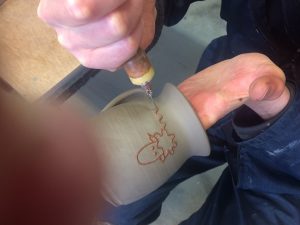 The slip trailer consists of the latex balloon/bag with a plastic tube which can take any of the 12 nozzles supplied. The 12 nozzles are really well engineered and can screw easily into the plastic tube. The 12 nozzles vary from very small (less than 1mm) all the way up to about 2mm, which means that you can alter the thickness of the line you trail, just by changing the nozzle. I would say that 12 nozzles are slightly overkill, as the difference between them is very slight. Four different nozzles would have sufficed for my needs. There are three pins varying in thickness, to put in the nozzle to prevent slip drying out if the trailer is left unused (and thus blocking the trailer). There is also a plastic end cap that screws onto the pipe (in the same way as the nozzle), which completely seals the trailer, which would be handy if say you want to continue using the slip trailer the next day without having to clean and refill it. There are no instructions included, but there are some on Mark’s website.
The slip trailer consists of the latex balloon/bag with a plastic tube which can take any of the 12 nozzles supplied. The 12 nozzles are really well engineered and can screw easily into the plastic tube. The 12 nozzles vary from very small (less than 1mm) all the way up to about 2mm, which means that you can alter the thickness of the line you trail, just by changing the nozzle. I would say that 12 nozzles are slightly overkill, as the difference between them is very slight. Four different nozzles would have sufficed for my needs. There are three pins varying in thickness, to put in the nozzle to prevent slip drying out if the trailer is left unused (and thus blocking the trailer). There is also a plastic end cap that screws onto the pipe (in the same way as the nozzle), which completely seals the trailer, which would be handy if say you want to continue using the slip trailer the next day without having to clean and refill it. There are no instructions included, but there are some on Mark’s website.
All I now needed were some pots to trail on. Luckily I had thrown 40 mugs that needed decorating with sheep for a local shop, so this was the ideal opportunity!
The first problem I had was how to get the slip into the latex bag. With all my other slip trailers you can simply depress them and suck the slip inside. However this slip trailer doesn’t suck. I quickly learnt the best way to fill it is to fill one of my old slip trailers with the slip and then squirt the slip into the latex bag. Hey presto my old slip trailers still have a use!
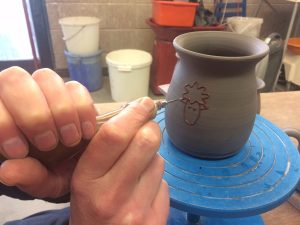 I started trailing the detail of the sheep onto the mug. To begin with it felt odd, mainly because I’m just not used to the shape of it. I feel the neck of the bag is a bit long and would probably consider cutting it shorter at some stage? I hardly had to exert any pressure to release the slip. I found once the trailer was filled and all the air expelled, air was never sucked back into the trailer, which meant absolutely no splodging of slip and no having to prime the trailer by squeezing out any air before going onto the pot. I ended up using two methods of holding the slip trailer whilst decorating these mugs. The first was to leave the mug on a Whirler wheel and hold the nib of the trailer with my right hand like a pen, whilst squeezing the bag with my left hand. This method was particularly good for fine detail, like the faces of the sheep. The second method was to hold the pot in my left hand and squeeze the trailer with my right hand. This allowed me to direct the trail with my right hand at the same time as moving the pot with my left hand. This worked best on larger areas, like the body of the sheep. The capacity of the bag is much larger than I thought it would be. I filled it twice to trail the outlines of 40 sheep. At the end of the job there was absolutely no ache in my hands, which is a first.
I started trailing the detail of the sheep onto the mug. To begin with it felt odd, mainly because I’m just not used to the shape of it. I feel the neck of the bag is a bit long and would probably consider cutting it shorter at some stage? I hardly had to exert any pressure to release the slip. I found once the trailer was filled and all the air expelled, air was never sucked back into the trailer, which meant absolutely no splodging of slip and no having to prime the trailer by squeezing out any air before going onto the pot. I ended up using two methods of holding the slip trailer whilst decorating these mugs. The first was to leave the mug on a Whirler wheel and hold the nib of the trailer with my right hand like a pen, whilst squeezing the bag with my left hand. This method was particularly good for fine detail, like the faces of the sheep. The second method was to hold the pot in my left hand and squeeze the trailer with my right hand. This allowed me to direct the trail with my right hand at the same time as moving the pot with my left hand. This worked best on larger areas, like the body of the sheep. The capacity of the bag is much larger than I thought it would be. I filled it twice to trail the outlines of 40 sheep. At the end of the job there was absolutely no ache in my hands, which is a first.
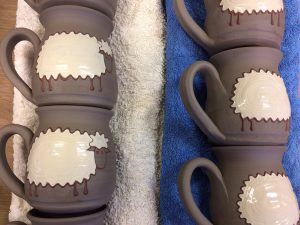 When it came to flooding much thinner white slip between the lines to create the sheep’s fleece, I discovered that the lack of resistance of the latex bag became a problem, as the slip just comes out too quickly. I had to resort back to my original slip trailer to do this, as it allows a higher degree of control with a thinner slip. However when it comes to trailing lines (with thicker slip) the Mark Dally slip trailer is head and shoulders above every other slip trailer I have used. One thing I discovered is that the nozzles from the Mark Dally slip trailer are interchangeable with the ones on my other slip trailer (xiem tools), which is an added bonus.
When it came to flooding much thinner white slip between the lines to create the sheep’s fleece, I discovered that the lack of resistance of the latex bag became a problem, as the slip just comes out too quickly. I had to resort back to my original slip trailer to do this, as it allows a higher degree of control with a thinner slip. However when it comes to trailing lines (with thicker slip) the Mark Dally slip trailer is head and shoulders above every other slip trailer I have used. One thing I discovered is that the nozzles from the Mark Dally slip trailer are interchangeable with the ones on my other slip trailer (xiem tools), which is an added bonus.
Once I was used to using the slip trailer it became a delight to operate. You can get a high degree of accuracy with it, as you can hold it like a pen and it solves my gripes with previous slip trailers I have bought, in that it doesn’t splodge and doesn’t cause your hands to ache. In short it is the best slip trailer I have used and I suspect the best slip trailer that you can purchase today. At £39 a shot this may seem expensive, but it’s cheap compared to the price of developing an RSI injury from using a thick walled rubber slip trailer for any length of time! I’m not sure about the longevity of the latex bag and plastic pipe? I’m hoping that Mark would sell the bag and plastic pipe separately (you’ll never need to replace the nozzles). I would be happy to buy a couple more bags and pipes if this were possible, as it would mean I could use more than one coloured slip without having to clean out the bag (this would be really handy for commemorative plates).
To purchase the Mark Dally Slip Trailer visit Mark’s site here:
Since writing this review Mark Has uploaded a video of how to use his slip trailer;

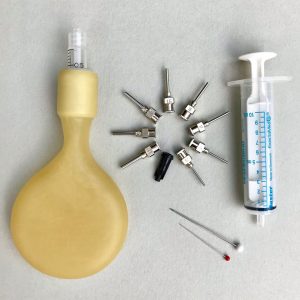
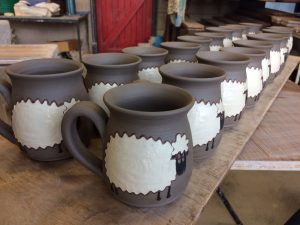
Hello, I am not a trailer of slip but I have seen details of the wonderful Mary Wondrausch slip trailer (also used by Hannah McAndrew) which is a lot cheaper than £39, in fact it’s free, with a little ingenuity (made out of a bicycle innertube). Here is a link to an article about it on Ron Philbeck’s website, https://www.ronphilbeckpottery.com/6blog/2009/1/7/mary-wondrausch-slip-trailers.html
Thanks for that Keith, I remember that Mary made her own slip trailers. being a keen cyclist i have no shortage of inner tubes!
Hi Keith, I did try the Mary Wondrausch slip trailer for quite a while, a few years back, but it didn’t offer me the sensitivity of feel that I needed. The tips I used at the time were glass pipette tips, which were great but used to break a lot, and the tube shape of the inner tube didn’t fit my hand as well as the round shape of the latex bag. For me when I’m slip trailing up to 5 hours in a day the price doesn’t matter. It’s all about the comfort, precision and above all the control.
Pingback: Clay Blog Review: January 2018 - Pottery Making Info